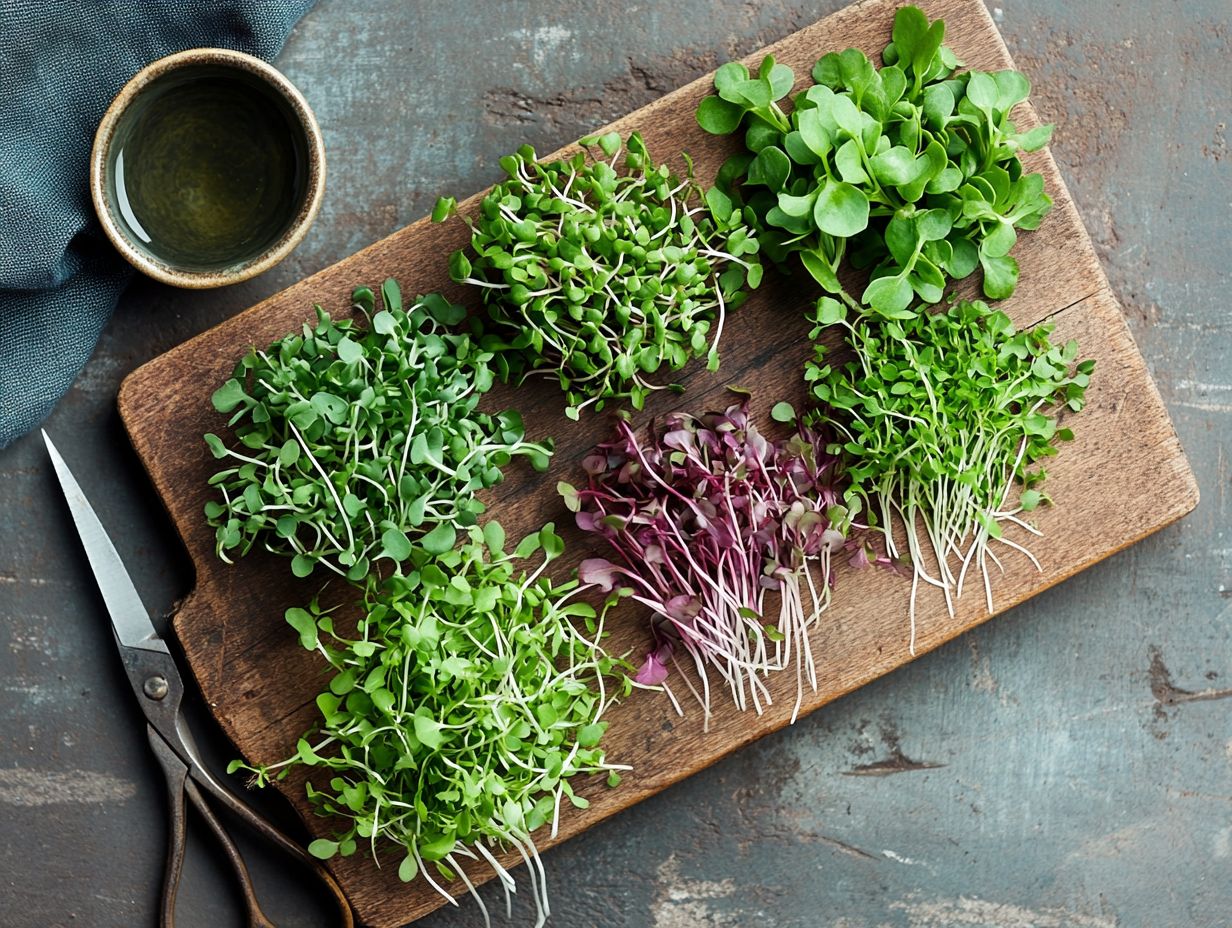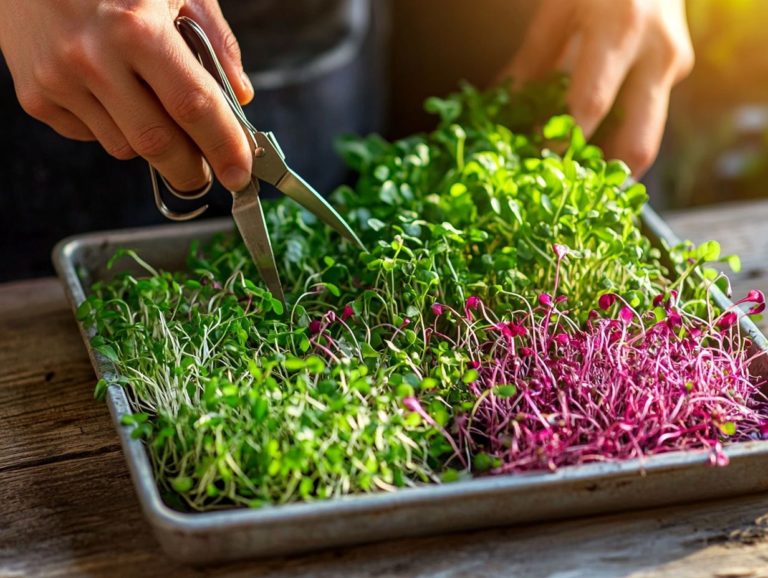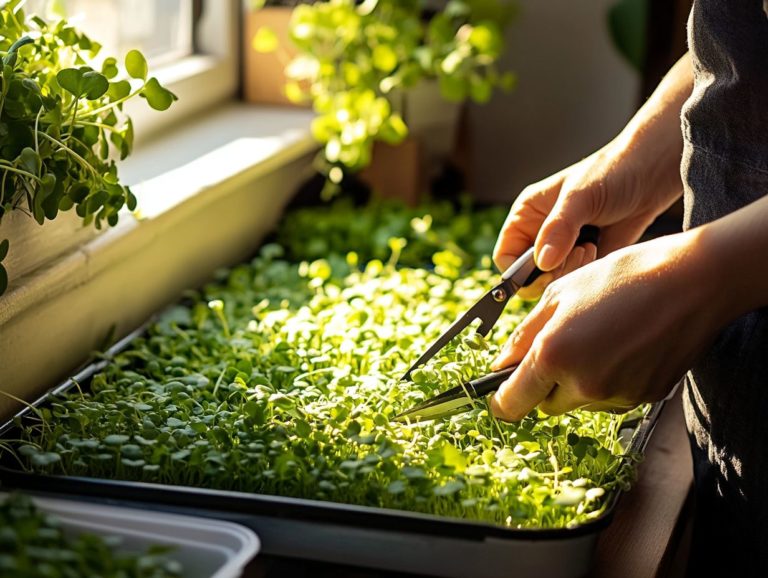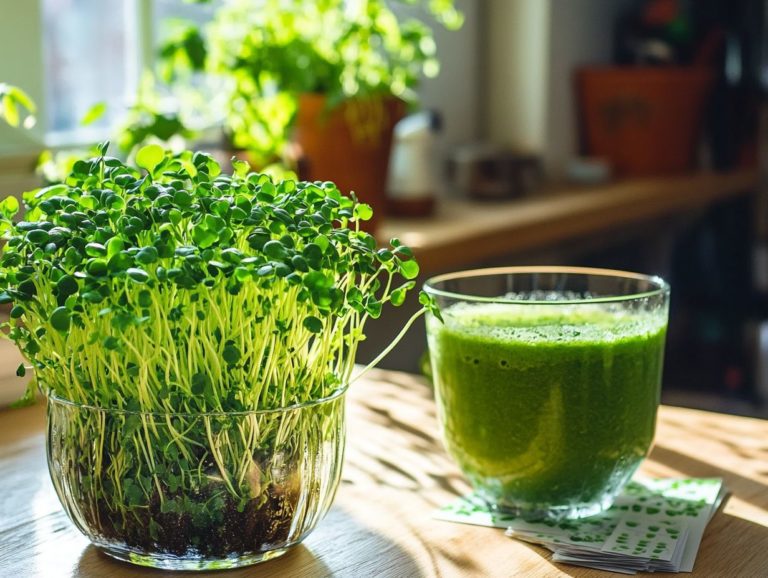5 Popular Microgreens with Easy Harvesting
Microgreens have truly transformed the culinary landscape, enchanting both chefs and home cooks with their vibrant flavors and remarkable nutritional advantages.
These petite greens deliver an unexpected burst of taste, adding a refreshing twist to your dishes while being surprisingly simple to cultivate.
In this article, you ll delve into the world of microgreens understanding what they are, why they ve become so popular, and how you can grow them right in your own kitchen.
You ll uncover five easy-to-harvest varieties and discover imaginative ways to incorporate them into your meals. Get ready to explore exciting ideas right away!
Contents
- Key Takeaways:
- 1. What Are Microgreens?
- 2. Why Are They Popular?
- 3. How to Grow Microgreens?
- 4. 5 Easy-to-Harvest Microgreens
- What Are the Nutritional Benefits of These Microgreens?
- How Long Does It Take to Harvest These Microgreens?
- What Are Some Tips for Harvesting Microgreens?
- How Can One Incorporate Microgreens into Their Diet?
- Are There Any Safety Concerns When Growing and Harvesting Microgreens?
- What Are Some Creative Ways to Use Microgreens in Cooking?
- How Can One Store Microgreens for Maximum Freshness?
- What Are Some Common Mistakes When Harvesting Microgreens?
- How Can One Grow Microgreens Year-Round?
- What Are the Different Types of Containers That Can Be Used for Growing Microgreens?
- What Are the Best Growing Mediums for Microgreens?
- What Are Some Common Pests and Diseases That Can Affect Microgreens?
- What Are Some Common Uses for Microgreens in the Culinary World?
- How Can Microgreens Benefit the Environment?
- Are There Any Disadvantages to Growing and Harvesting Microgreens?
- Frequently Asked Questions
Key Takeaways:

- Microgreens are small plants harvested early for their rich nutrients.
- Popular types like broccoli, kale, and radish grow quickly in just 1-2 weeks!
- Adding microgreens boosts flavor, texture, and nutrition in meals.
1. What Are Microgreens?
Microgreens are young, edible plants that you can harvest shortly after germination, typically within 7 to 21 days.
With a variety of species at your fingertips, such as radish, broccoli, and arugula microgreens, they present an ideal option for indoor gardening enthusiasts like yourself who desire easy-to-grow, nutrient-packed additions to your home garden.
These tiny powerhouses are loaded with vitamins and minerals that enhance the nutritional profile of your meals.
Growing them in seed trays is remarkably simple, allowing even novice gardeners to cultivate fresh greens without needing a sprawling outdoor space.
Their rapid germination makes them an exciting endeavor for anyone eager to witness quick results, making them perfectly suited for urban lifestyles.
The vibrant colors and delicate flavors of microgreens can truly elevate your dishes, which is why they ve become a favorite among both chefs and home cooks alike.
2. Why Are They Popular?
The popularity of microgreens has surged dramatically, thanks to their impressive nutritional profile, vibrant flavors, and the ease with which they can be grown indoors.
This makes them a top choice for health-conscious individuals and home microgreens enthusiasts alike.
These tiny powerhouses can elevate any meal. They attract both home cooks eager to enhance everyday dishes and professional chefs searching for unique, nutrient-rich ingredients.
Their culinary versatility means they can be seamlessly added to salads, sandwiches, and even used as garnishes, turning ordinary meals into gourmet experiences.
Cultivating microgreens at home is particularly appealing to urban dwellers who may lack outdoor gardening space.
This accessibility encourages a wider audience to embrace this sustainable practice while enjoying the fresh taste and numerous health benefits they provide.
3. How to Grow Microgreens?
Growing microgreens is a remarkable journey that s surprisingly simple, requiring just a few key tools primarily seed trays and high-quality seeds.
With the right lighting and watering techniques, you can achieve fast germination and nurture healthy growth right in your indoor gardening setup.
To begin, consider your seed selection. Popular choices like basil microgreens and pea microgreens stand out for their ease of cultivation and delightful flavors.
Once you’ve chosen your seeds, it s time to prepare your seed trays. Fill them with a nutrient-rich soil mix, ensuring it s moistened just right not soaking wet.
After sowing the seeds evenly across the surface, place the trays in a warm, bright spot to encourage germination.
Maintaining a consistently humid environment using a mist spray or a humidity dome can significantly speed up sprout growth.
By providing regular care, including gentle watering and monitoring light exposure, you’ll be rewarded with a bountiful harvest in just a few weeks.
Microgreens truly make for an excellent project for anyone eager to embark on the adventure of indoor gardening.
Start your microgreens journey today and enjoy fresh flavors at home!
4. 5 Easy-to-Harvest Microgreens
If you’re stepping into the realm of home microgreens, beginning with easy-to-harvest options like radish, broccoli, cabbage, kohlrabi, and arugula microgreens offers a delightful and uncomplicated introduction to indoor gardening. This approach guarantees a bountiful, nutrient-packed harvest that you can take pride in.
These little greens not only burst with vibrant flavors but also come packed with impressive health benefits. Each type thrives in well-drained soil and requires ample light, making them ideal for your windowsill or a cozy indoor setup.
Take radish microgreens, for example; they deliver a peppery kick. Broccoli microgreens are milder yet rich in cancer-fighting nutrients. Cabbage microgreens offer a touch of sweetness, kohlrabi brings a satisfying crunch. Arugula adds a zesty flair to your dishes.
Harvest these gems easily by snipping them just above the soil line it s as satisfying as it sounds! To maintain their freshness, store them in airtight containers in the fridge, ensuring that their delightful flavors and nutritional benefits remain intact.
What Are the Nutritional Benefits of These Microgreens?
Microgreens, like radish and broccoli microgreens, present a remarkable array of nutritional benefits, brimming with vitamins, minerals, and antioxidants that significantly enhance your overall health and wellness.
These greens are considered superfoods due to their impressive concentration of essential nutrients. For example, radish microgreens are packed with vitamin C and potassium, both of which play crucial roles in bolstering immune function and supporting cardiovascular health.
Likewise, broccoli microgreens shine with their rich content of sulforaphane, a compound renowned for its cancer-fighting properties, as well as vitamins A, C, and K key players in promoting bone health and revitalizing your skin.
By incorporating these tiny nutritional powerhouses into your daily meals, you can quickly boost your intake of vital nutrients, fostering longevity and mitigating the risk of chronic diseases.
How Long Does It Take to Harvest These Microgreens?

Most microgreens, such as radish and broccoli microgreens, grow quickly, often allowing you to harvest them within 7 to 21 days, depending on the variety and the conditions in which they are grown.
These greens grow quickly because their seeds are small and they thrive in ideal conditions think light, warmth, and moisture. Temperature is a key player here, as many microgreens sprout faster in warmer environments. However, be cautious; excessive humidity can invite mold problems.
Seed quality, soil type, and your watering technique affect how fast these greens grow.
With a little care and attention, you can savor fresh microgreens in just a couple of weeks, making them a delightful choice for home gardeners and culinary enthusiasts alike.
What Are Some Tips for Harvesting Microgreens?
Ready to enjoy your fresh microgreens? Here are some quick tips for harvesting!
Successfully harvesting microgreens, like radish and sunflower microgreens, hinges on a few essential techniques. You’ll want to equip yourself with sharp scissors, choose the right moment for harvesting, and gently rinse them to preserve their delicate nature. Additionally, avoiding the top mistakes in growing microgreens can also ensure a bountiful harvest.
- For optimal flavor and nutrient retention, aim to harvest them when they reach about two to three inches tall typically between 7 to 21 days after sowing, depending on the variety.
- Remember to use clean, sanitized tools to prevent any contamination; it s a crucial step in maintaining quality.
- Consider harvesting during the early morning or late afternoon when temperatures are cooler, as this approach helps keep their moisture content intact.
Once you ve cut them, place the microgreens in a breathable container and pop them in the refrigerator. This simple step can extend their freshness, allowing those vibrant flavors to truly shine in your culinary creations.
How Can One Incorporate Microgreens into Their Diet?
Incorporating microgreens like basil and arugula can infuse your meals with vibrant flavors and essential nutrients. They enhance everything from salads to sandwiches and garnishes, supporting a healthy lifestyle.
These tiny greens pack a powerful punch. They can elevate your smoothies and serve as a colorful topping for pizzas and pasta dishes. To enhance your garden, learn how to choose microgreen varieties that will thrive. Imagine a refreshing summer salad adorned with radish microgreens or a savory omelet sprinkled with cilantro microgreens for an aromatic twist.
The culinary possibilities are vast, inviting creativity in both everyday meals and gourmet presentations. You will also enjoy significant health benefits, including increased antioxidants, vitamins, and minerals that support your overall well-being.
Are There Any Safety Concerns When Growing and Harvesting Microgreens?
Growing microgreens is safe, but some precautions are necessary. Focus on using clean seeds and maintaining proper hygiene throughout your indoor gardening process.
Ensure enough air circulation to keep mold at bay. Regularly clean all surfaces, tools, and containers involved in the growing process. It’s also crucial to monitor environmental conditions like humidity and temperature, as neglecting these factors can lead to bacterial growth.
Thoroughly washing the harvested microgreens before consumption is an effective way to reduce the risk of ingesting harmful pathogens. By implementing these safety measures, you can enjoy fresh and delicious microgreens without worry.
What Are Some Creative Ways to Use Microgreens in Cooking?
Imagine infusing your dishes with the exquisite touch of microgreens. Radish microgreens can garnish your soups, while basil microgreens elevate your pasta, enhancing both flavor and presentation.
These vibrant little greens are not just packed with nutrients; they bring an exciting array of textures and colors that transform the entire dining experience. Toss a handful of sunflower microgreens into a crisp salad or wrap pea shoots around succulent seafood like shrimp or scallops for an eye-catching appetizer.
In Asian cuisine, a sprinkle of cilantro microgreens can elevate the freshness of a sushi platter. Experimenting with different varieties opens the door to innovative pairings, ensuring every meal becomes a delightful surprise for you and your guests.
How Can One Store Microgreens for Maximum Freshness?
Storing microgreens properly is essential for preserving their best freshness and nutritional benefits. Refrigerate them in perforated bags or containers to ensure proper airflow.
Keep the temperature consistently cool, ideally between 32 F and 40 F, to extend their shelf life. Pay attention to moisture levels in the storage environment; excess moisture can lead to mold and spoilage.
To maintain that delicate balance, consider using dry paper towels to soak up any surplus moisture. It s also wise to hold off on washing the microgreens until just before you’re ready to enjoy them. This simple step helps preserve their flavor and texture, making them a delightful enhancement to any meal.
What Are Some Common Mistakes When Harvesting Microgreens?

Common mistakes when harvesting microgreens include cutting too low, mishandling, and neglecting to rinse them properly. These errors can compromise the taste and quality of your harvest.
Trimming too close to the soil can introduce contamination and result in a bitter flavor. Carelessly handling those delicate shoots can lead to bruising or damage, detracting from their visual appeal.
Focus on using sharp, sterile scissors and approach the task with gentleness. This preserves the fragile structures of your microgreens. A thorough yet gentle rinse will eliminate any residual soil or debris, enhancing their flavor profile.
Pay attention to these details for a fresher and more vibrant microgreen experience!
How Can One Grow Microgreens Year-Round?
Growing microgreens year-round is entirely within your reach with the right indoor gardening setup. Control lighting, temperature, and humidity to ensure consistent growth, regardless of the weather outside.
Invest in a dependable grow light to create this ideal environment. It mimics natural sunlight, delivering the spectrum necessary for photosynthesis.
Maintain the perfect temperature typically between 65 to 75 degrees Fahrenheit. This range is essential for most varieties to thrive. Manage humidity using a simple humidity dome or misting system. These methods accelerate seed germination and minimize the risk of mold.
Choose suitable species like radish, sunflower, and peas. These varieties flourish beautifully indoors and provide a delightful range of flavors and nutritional benefits, making them stellar options for your year-round microgreen garden. For best results, consider following these 5 tips for successful microgreen germination.
What Are the Different Types of Containers That Can Be Used for Growing Microgreens?
Explore exciting containers for your microgreens! You can choose from traditional seed trays to creatively repurposed items, giving you the freedom to express your style in indoor gardening.
Containers come in an array of materials, including plastic, wood, and biodegradable options. Each has its unique benefits. Plastic seed trays are lightweight and easy to clean, making them convenient, though they might not win any eco-friendliness awards.
Wooden boxes lend a charming rustic vibe but may require more upkeep to prevent rot. If you re crafty, consider using items like egg cartons, yogurt cups, or shallow baking dishes as fantastic starter containers.
Just remember to ensure that any reused item has drainage holes. Maintaining proper moisture is essential for nurturing healthy microgreens.
What Are the Best Growing Mediums for Microgreens?
Choosing the right growing mediums for your microgreens is essential. It greatly influences how fast seeds sprout and overall health. Popular options include soil, coconut coir, and hydroponic mats.
These mediums differ in texture, water retention, and nutrient availability. Soil offers natural nutrients and beneficial microorganisms that foster healthy development but may also bring challenges like pests or diseases.
Coconut coir is an eco-friendly choice that excels in moisture retention and aeration. However, it may need added nutrients for optimal growth.
Hydroponic mats provide a soilless growing option that gives direct access to nutrients, encouraging rapid growth. They can be pricier and less forgiving if you slip up on watering. By exploring these various mediums, you can make informed choices to cultivate vibrant and robust microgreens. For those just starting out, check out this guide on how to grow microgreens for beginners.
What Are Some Common Pests and Diseases That Can Affect Microgreens?
Microgreens can be quite vulnerable to a range of pests and diseases. One common issue is damping-off, a disease that causes seedlings to rot. Aphids are another threat, appearing seemingly out of nowhere and feasting on tender leaves.
As an indoor gardener, it s essential to maintain a clean growing environment. You can cultivate vibrant microgreens by understanding these challenges. Establish optimal watering practices and ensure proper air circulation to reduce the chances of issues arising.
You can also incorporate beneficial insects like ladybugs to deter pests. Regular monitoring and taking immediate action at the first sign of trouble will further protect your delicate greens. Imagine the satisfaction of growing your own fresh greens!
What Are Some Common Uses for Microgreens in the Culinary World?
Microgreens enhance your dishes in both looks and taste! They are essential for adding visual appeal and flavor to everything from gourmet salads to fine dining entrees.
These tiny greens are bursting with flavor and nutrients. When thoughtfully incorporated, they elevate even the simplest dish to gourmet status. For instance, vibrant pea shoots add a sweet crunch to Asian-inspired stir-fries or sushi rolls, while delicate radish microgreens introduce a peppery zest that complements rich seafood dishes. To enhance your smoothies, check out the top 5 microgreens for smoothies.
Sprinkle basil microgreens over a fresh Caprese salad for an aromatic lift, or fold beet microgreens into a hearty soup for a striking presentation. To explore different options, check out microgreen varieties: a guide for beginners. Their versatility allows you to express creativity across various cuisines!
How Can Microgreens Benefit the Environment?

You can benefit the environment by growing microgreens. These plants help reduce food miles, which is the distance food travels from where it s grown to where it s eaten, and they enhance local biodiversity.
When you cultivate these little powerhouses, you enjoy fresh produce without the need for extensive agricultural land. This practice conserves water and minimizes reliance on harmful pesticides and fertilizers.
By growing them at home, you connect with local ecosystems, attract beneficial insects, and enrich the soil, supporting surrounding wildlife.
Are There Any Disadvantages to Growing and Harvesting Microgreens?
While growing microgreens has many benefits, it also presents challenges. They have a short shelf life and require careful attention to prevent common issues.
These hurdles can deter you from fully embracing this rewarding gardening pursuit. The rapid growth cycle means you need to harvest promptly to avoid wilting. Establish a flexible harvesting schedule while monitoring their growth closely.
Improper light or moisture levels can lead to problems like mold or poor germination. To mitigate these issues, ensure proper drainage and air circulation. By staying informed and using diligent monitoring techniques, you can navigate these challenges and enjoy the rewards of microgreen cultivation.
Frequently Asked Questions
What are microgreens?
Microgreens are young vegetable plants harvested early, usually within 7-14 days after sprouting. They are packed with nutrients and considered a superfood.
Why are microgreens becoming popular?
Microgreens are gaining popularity because they are simple to grow and need very little space. They can be harvested quickly and bring a burst of flavor and nutrition to your meals.
What are the top 5 popular microgreens that are easy to harvest?
The top five popular microgreens that are easy to harvest include sunflower, pea shoots, radish, broccoli, and kale. These varieties grow quickly and can be cut easily with scissors.
How do you harvest microgreens?
To cut microgreens, use clean scissors to snip the stems just above the soil when they reach a height of 1-2 inches. Rinse and pat them dry before enjoying!
What are the benefits of cutting microgreens at an early stage?
Cutting microgreens early ensures you get the maximum nutrients. They taste more tender and flavorful when young than when fully grown.
Can you regrow microgreens after cutting?
Yes, you can regrow microgreens. Leave about an inch of the stem in the soil and water as usual. You can harvest them 1-2 more times!






